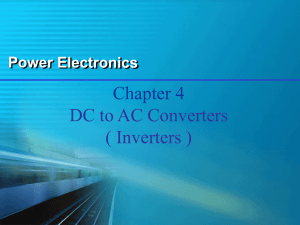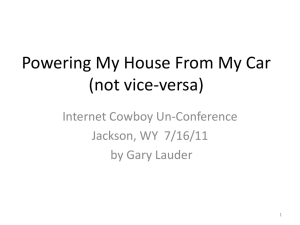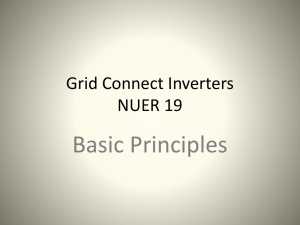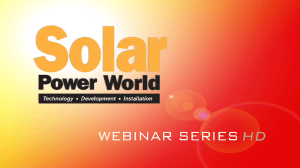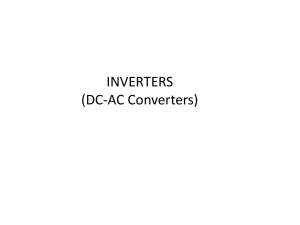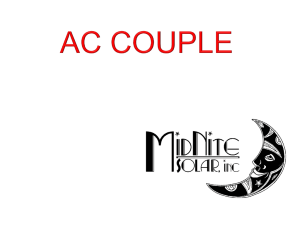self-commutation inverters - Rose
advertisement
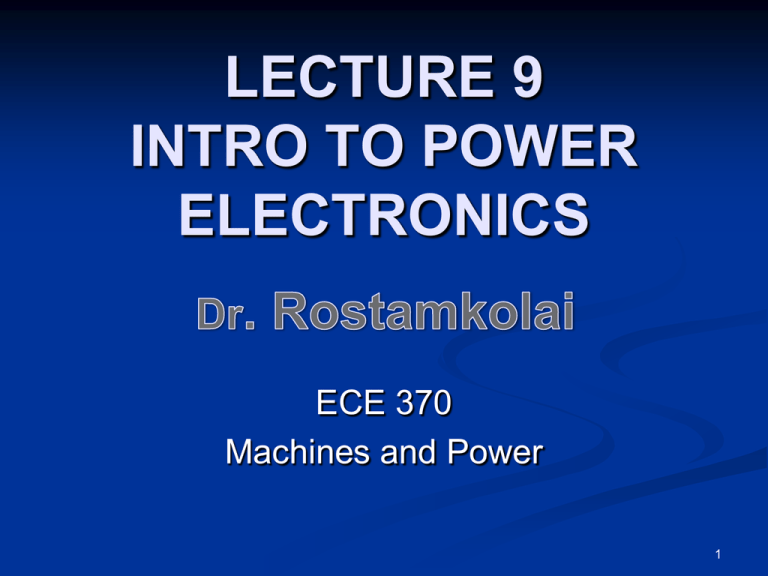
LECTURE 9 INTRO TO POWER ELECTRONICS ECE 370 Machines and Power 1 INVERTERS Perhaps the most rapidly growing area in modern power electronics is static frequency conversion This is conversion of ac power at one frequency to ac power at another frequency by means of solid-state electronics 2 INVERTERS Traditionally there have been two approaches to static ac frequency conversion: 1. Cycloconverter 2. Rectifier-inverter 3 INVERTERS The cycloconverter is a device for directly converting ac power at one frequency to ac power at another frequency The rectifier-inverter first converts ac power to dc power and then converts the dc power to ac power again at a different frequency 4 INVERTERS A rectifier-inverter is divided into two parts: 1. A rectifier to produce dc power 2. An inverter to produce ac power from the dc power 5 RECTIFIERS The basic rectifier circuits for converting ac power to dc power was covered previously These circuits have one problem from a motor-control point of view Output voltage is fixed for a given input voltage This problem can be overcome by replacing diodes in these circuits with SCRs 6 RECTIFIERS The figure below shows a three-phase fullwave rectifier circuit with the diodes in the circuits replaced by SCRs 7 RECTIFIERS 8 RECTIFIERS The average output voltage is found from: Vdc 3 / 2 / 6 vab d ( t ) 3 3 Vm cos 9 RECTIFIERS The average dc output voltage from this circuit depends on when the SCRs are triggered during their positive half-cycles If they are triggered at the beginning of the half-cycle, this circuit will be the same as that of a three-phase full-wave rectifier with diodes 10 RECTIFIERS If the SCRs are never triggered, the output voltage will be 0 V For any other firing angle between 0˚ and 90˚ on the waveform, the dc output voltage will be somewhere between the maximum value and 0 V 11 RECTIFIERS When SCRs are used instead of diodes in the rectifier circuit to get control of the dc voltage output, this output voltage will have more harmonic content than a simple rectifier would, and some form of filtering on its output is needed The following figure shows an inductor and capacitor filter placed at the output of the rectifier to help smooth the dc output 12 RECTIFIERS 13 INVERTERS Inverters are classified into two basic types by the utilized commutation technique: External Commutation Self Commutation 14 EXTERNAL COMMUTATION INVERTERS External commutation inverters are inverters in which the energy required to turn off the SCRs is provided by an external motor or power supply 15 EXTERNAL COMMUTATION INVERTERS An example of an external commutation is shown below 16 EXTERNAL COMMUTATION INVERTERS The inverter is connected to a three-phase synchronous motor, which provides the countervoltage necessary to turn off one SCR when its companion is fired The SCRs in this circuit are triggered in the following order: SCR1, SCR6, SCR2, SCR4, SCR3, SCR5 17 EXTERNAL COMMUTATION INVERTERS When SCR1 fires, the internal generated voltage in the synchronous motor provides the voltage necessary to turn off SCR3 Note that if the load is not connected to the inverter, the SCRs would never be tuned off and after ½ cycle a short circuit would develop through SCR1 and SCR4 This inverter is also called a loadcommutated inverter 18 SELF-COMMUTATION INVERTERS If it is not possible to guarantee that a load will always provide the proper countervoltage for commutation, then a self-commutation inverter must be used Self-commutation inverters can be designed using GTOs, IGBTs, or power transistors 19 SELF-COMMUTATION INVERTERS There are three major types of selfcommutation inverters: 1. Current source inverters (SCI) 2. Voltage source inverters (VSI) 3. Pulse-width modulation inverters (PWM) 20 SELF-COMMUTATION INVERTERS Pulse-width modulation is the process of modifying the width of the pulses in a pulse train in direct proportion to a small control signal 21 SELF-COMMUTATION INVERTERS The principle of single-phase inverter operation can be explained with the following figure 22 SELF-COMMUTATION INVERTERS The figure shown is a three-phase inverter using power transistors as active devices 23 SELF-COMMUTATION INVERTERS Since power transistor are selfcommutating, no special commutation components are included in this circuit In this circuit, the transistors are made to conduct in the following order: T1, T6, T2, T4, T3, T5 The output phase and line voltage from this circuit are shown on the next slide 24 SELF-COMMUTATION INVERTERS 25 SELF-COMMUTATION INVERTERS A three-phase output can be obtained from a configuration of six transistors and six diodes 26 SELF-COMMUTATION INVERTERS Two types of control signals can be applied to the transistors: 180o conduction or 120o conduction 27 SELF-COMMUTATION INVERTERS For 180 degrees operation, each device conducts 180 degrees The sequence of firing is: 123, 234, 345, 456, 561, 612 The gating signals are shifted from each other by 60 degrees 28 SELF-COMMUTATION INVERTERS 29 SELF-COMMUTATION INVERTERS For 120 degrees operation, each transistor conducts for 120 degrees The sequence of firing is: 61, 12, 23, 34, 45, 56, 61 30 SELF-COMMUTATION INVERTERS 31 SELF-COMMUTATION INVERTERS Current source inverters and voltage source inverters are different from PWM inverters and have been used for a long time PWM inverters require more complex control circuitry and faster switching components than CSI and VSI 32 SELF-COMMUTATION INVERTERS 33 SELF-COMMUTATION INVERTERS In the current source inverter, a rectifier is connected to an inverter through a large series inductor LS The inductance of LS is sufficiently large that the dc current I constrained to be almost constant 34 SELF-COMMUTATIION INVERTERS The SCR current output waveform will be roughly a square wave since IS is constrained to be nearly constant The line-to-line voltage will be triangular It is easy to limit overcurrent conditions in this design, but the output voltage can swing widely in response to changes in load 35 SINGLE-PHASE CURRENT SOURCE INVERTER A single-phase CSI circuit with capacitor commutation is shown below 36 SINGLE-PHASE VOLTAGE SOURCE INVERTER In the voltage source inverter, a rectifier is connected to an inverter through a series inductor LS and a parallel capacitor C The capacitance of C is sufficiently large that the voltage is constrained to be almost constant 37 SINGLE-PHASE VOLTAGE SOURCE INVERTER The SCR line-to-line voltage output waveform will be roughly a square wave, since the voltage Vc is constrained to be nearly constant The output current flow will be approximately triangular 38 SINGLE-PHASE VOLTAGE SOURCE INVERTER Voltage variations are small in this circuit, but currents can vary wildly with variations in load, and overcurrent protection is difficult to implement The frequency of both current and voltage source inverters can be easily changed by changing the firing pulses on the gates of the SCRs, so both inverters can be used to drive ac motors at variable speeds 39
